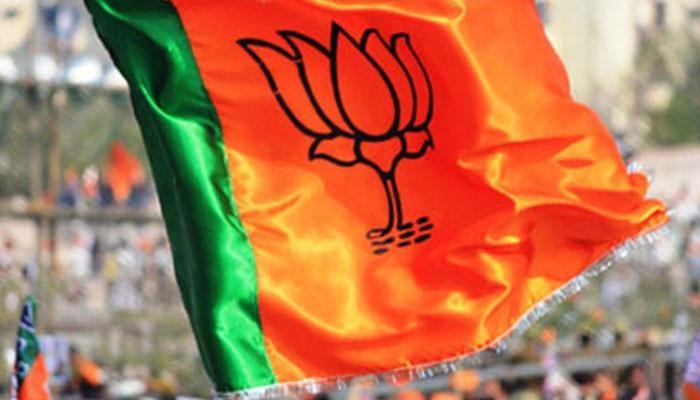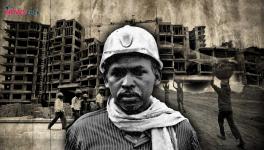Why Does Urban India Continue to Vote for BJP?

This is a question that has been festering in our minds for quite some time. There can be no doubt that the present crisis of neoliberalism is affecting urban Indians as much as the the rural. Yet, while the crisis in rural area resulted in an electoral loss to the ruling party, BJP’s urban support has consolidated even more.
Of the 99 seats that the BJP won in the recent Gujarat assembly elections, 48 were in urban. This is a success rate of 82.7% in urban areas with victory margins sometimes as high as 44295.
Is this strong urban support the result of BJP’s economic growth model in Gujarat? No. The explanation for the fact that despite Gujarat lagging behind other states in terms of human development indicators, lies elsewhere.
Why did it not manifest that starkly in Gujarat?
Historically, in India, the mobilisation of large organised working-class was central to the politics of urban areas. The large organised work force of industries in and around the cities, e.g. textiles mills in Delhi and Bombay, were at the centre of not only the trade union movements, but the left politics as well.
The politicisation of the working class, mainly by the Left parties, led to a discourse where the economic discontent reflected mostly in terms of class antagonism against the management or the state itself. By and large, this secular outlook helped in fomenting the unity of the working masses. But, this also went together with a dichotomy between electoral politics and working-class politics. While workers went with left in trade union politics, they went with other secular political formations electorally.
Still, the fact remains that the large presence of trade union movement kept the Jan Sangh and the RSS at bay. The RSS was present but it drew its base and strength not from the working class, but rather from the trading community. Hence, at one point of time, the BJP was termed as a ‘Baniya’ party. The cities’ trading communities were not into production, but rather more into money lending and mercantile activities. This mercantile class did not have a large mass base and even their financial muscle was not substantial enough.
As a result, the urban India, comprising of all these sections did not empathise with the BJP or their communal agenda to a large extent. This continued till the 80s. There are very many anecdotes to narrate how the trading community would go to the office of the Congress party to pay election fund etc., but would ask the Jan Sangh to come to their home but not visit their offices, thus openly associating with the first and clandestinely with the other.
Changing situation post 1990
After the neoliberal onslaught of the 1990s, the bigger factories were shifted away from the cities. The de-scaling or the fragmentation of production became the new mantra for the capitalists across the world. As a result, the strength of the organised working class weakened considerably in the urban areas. The ancillary industry model of production had a central supply chain (say components of a Maruti car), with different components being manufactured in different places.
This ancillarisation meant not just massive capital accumulation, it also led to the weakening of bargaining power of the working class and consequently the weakening of working class politics and ideology in the cities. Imagine the city of Kanpur could elect a Left MP in Lok Sabha before the 90s but post that period the same person got just 5 thousand votes. This was the political impact.
Eventually this led to the formation of a large informal sector in the urban centres. Unlike in the past, this informal sector had very few links to production. The workers of this sector hardly had any unions and as a result, were not much politicised. The cities became more service driven centres rather than production. Cities became the markets for production rather than centres of production which they once were.
The rise of RSS and BJP
It is in this background - changing production processes, coupled with the inability of the progressive forces to either comprehend or adapt to the changing urban spaces - that the RSS model of mobilisation started gaining ground.
As discussed before, RSS model of mobilisation, which is not based on factory floor working class struggles but on communal conflagration, found a fertile ground in this changed scenario.
In this period many cities saw communal mobilisations, mainly mobilisation of Hindus against Muslims – be it Bombay, Surat or Aligarh. Shiv Sena in Maharashtra followed similar path as BJP.
Interestingly, the fall in the industrial workers is proportional to the rise in communal riots in many of these cities. The RSS - BJP mastered the art communal mobilisation and built its organisation on the tenets of religious hate communal polarisation. The communities were indoctrinated with all sorts of falsehood and religious hate was assiduously cultivated.
Eventually this led to the consolidation of their base in the urban areas. A large section of the new urban working class was into the small and petty production especially the artisans and amongst whom were substantial number Muslims. This section was polarised on religious lines, with RSS-BJP stocking hatred against the Muslim craftsmen and petty producers.
Gujarat
Gujarat witnessed more than just a general trend of capitalist development. Four major episodes that led to a consolidation of the communal forces in this state. The first was the Maha Gujarat movement of 1956, followed by the Nav Nirman movement of 1974, then the anti-reservation movement in 1981, which was followed by a string of various communal mobilisations over the years – since the 1990s.
Despite Gujarat having a large working class base, there was no substantial political resistance to the communalisation because even during the Mahatma Gandhi era, trade unions were kept apolitical. As a result, even when the mills in Ahmedabad were closing down in the 1990s, there was little resistance from the workers, when they lost substantially under the infamous Bombay Industrial relations (BIR) act .
The de-politicisation of the workers could be explained from the survey conducted by the department of Sociology of South Gujarat University in 1985, which shows that just 3.5% of the total textile workmen in Surat city. What more, 86% of the workers did not know if any labour union existed.
Another commentator said that the communalisation of the urban areas is so complete that there is ‘no further scope left’ for further polarisation. The process according to Prof Dey of Ahmedabad University has reached its zenith.
Communities were ghettoised. If one has to search for a house in Ahmedabad city, one has to introduce herself with her case (called ‘Atak’ in Gujarati), implying whether one is a Muslim or Hindu.
Surprising was the trend in recent elections, where some of the Muslim localities in urban areas have voted for the BJP. This was explained with not just the factor of fear, which is there, but also by the narrative of ‘if one has to work peacefully’ then it is only the BJP that can provide such an environment. The urban centres throughout the state of Gujarat are void of any other political formations, giving the BJP a free arena in which to carry their agenda further.
Also lay at the root of the politics of polarisation is the Gujarat model of development. Rajdeep Sardesai, a senior journalist while covering Gujarat catches the psyche of such an urban voter quite vividly. When asked about the impact of firing on the Patel community, a voter replied that he was completely anguished, but he will still vote for BJP as he is an avowed Hindu and only the BJP represents the Hindu community.
The lessons of Gujarat elections are clear. The urban consolidation behind BJP has not happened on the issues of development, but rather on communal polarisation.
RSS-BJP’s exclusive agenda of communal politics, also leave the field open for the left to intervene in urban livelihood issues and this would mean struggle for utilities like better transport, housing, water, education, health, sanitation etc. Only through this shall the politics of urban spaces will take a different course.
In tandem with the struggle of urban livelihood issues, an ideological collision with Hindutva politics is also required.
The wrangling on who is a better Hindu will not help. This was experienced in the Gujarat elections where the Congress deliberately shirked from speaking on the issue of atrocities on Muslims and gave very few candidates from the minority community.
Even though Gujarat has 9 % Muslim population, there are just 3 Muslim MLAs in an Assembly of 182. This creates a fear in these sections and they will either gravitate to the ruling dispensation who they hope will offer them some protection or not move at all. One of the feature of less polling in urban areas could be attributed to this phenomenon.
The choice is clear. There is not going to be those large working-class urban bases, with the present form of capitalism in the country. Hence, the arenas of reproduction of capitalism and consumption must be targeted with changed organisational forms. At the same time, the communal discourse must be challenged with ideological clarity. For, the dynamics of urbanisation in the neoliberal capitalism will produce rebels, but the rebellion must be against the state and not against the communities fighting each other.
Get the latest reports & analysis with people's perspective on Protests, movements & deep analytical videos, discussions of the current affairs in your Telegram app. Subscribe to NewsClick's Telegram channel & get Real-Time updates on stories, as they get published on our website.
























